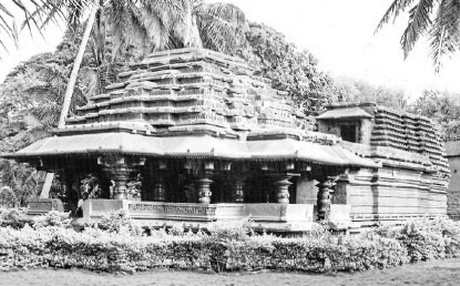
The New Indian Express
Kamal Basti: A Jain Wonder In Stone
By G Nataraja Perumal
07th April 2013 12:00 AM
 Kamal Basti is an ancient Jain temple dating as far back as 1000 AD and situated in the famous Belgaum fort in Karnataka. Built in a typical Chalukya style, it stands testimony to the architectural genius and aesthetic sense of our forefathers. Even after hundreds of years, it still looks fresh; time cannot wither the temple’s old charm. It is a sacred monument made of stones and the stones have willingly yielded to the design and pattern the sculptors had in mind. Otherwise, such a gorgeous structure would not have become reality. Kamal Basti is a marvel and a poetry in stone. The lush green garden around adds to the aura and serenity of the temple all the more.
Kamal Basti is an ancient Jain temple dating as far back as 1000 AD and situated in the famous Belgaum fort in Karnataka. Built in a typical Chalukya style, it stands testimony to the architectural genius and aesthetic sense of our forefathers. Even after hundreds of years, it still looks fresh; time cannot wither the temple’s old charm. It is a sacred monument made of stones and the stones have willingly yielded to the design and pattern the sculptors had in mind. Otherwise, such a gorgeous structure would not have become reality. Kamal Basti is a marvel and a poetry in stone. The lush green garden around adds to the aura and serenity of the temple all the more.
The front hall, Muga mandapam as it is called, is truly a majestic structure and a masterpiece, to say the least. It is in the form of an inverted lotus with 72 unfolded petals and hence the name Kamal Basti. Each petal, the Jains believe, represents a Tirthankara. Those in the know of things may question the number of Tirthankaras. The Jains have got a poetic explanation. They say there were, are and ever will be 24 Tirthankaras and hence the total no of petals (24X3=72) add up to 72 - philosophically sounds well. The walls of the temple are engraved with intricate designs, borders and sculptures, which are breathtakingly beautiful. Hundreds of minuscule statues of Vinayak have been woven into the labyrinth of rocks; artisans also figure alongside. Inscriptions, as concrete evidence of history, are also there. The pillars supporting the structure are so shiny and shapely that one cannot resist the temptation of touching them to get a feel of the texture. They reflect things that are at a distance from them - truly, a mirror in stone!
The front hall leads one to the prayer hall, where tranquillity reigns supreme. The hall is full of ethereal, spiritual and transcendental vibrations. The devotees are in deep meditation. In the prayer hall, one could find statues of Jain monks of high order like Adinath, the first Tirthankara, sitting in Padmasan and Bhagwan Sumatinath standing with finely formed eyelids gently closed. Bhagwan Parshwanath is seated under the shade of seven-hooded Nagaraj. The statues are naked but the nakedness of monks, as that of babies, have only purity, innocence and sacredness to reveal.
This is the only Jain temple in the whole world, where there are statues of Nava Grahas - carved in monolithic stone - that are represented by nine Tirthankaras. It is believed that the Jains of the bygone centuries might have faith in planetary influence over human affairs.
In fact, Kamal Basti has more surprises. Past the prayer hall is installed the idol of Neminath, the 22nd Tirthankara - found out at a later date but prominence has been given to Him. The statue of Neminath, who renounced his very kingdom to become a monk, is quite captivating and divine-inducing; he is seated on a highly decorated pedestal, worthy of his spiritual eminence. This part of the temple is equivalent to the sanctum sanctorum, where daily worship takes place. Much peace and contentment comes to one’s heart, as one bows one’s head before these monks, famed for their compassion, non-violence and absolute faith in vegetarianism and universal brotherhood. Apart from Jainalaya, within the fort are temples of Durga and Shiva, and mosques which emphasises the unity, integrity, oneness and harmony of all religions. For those visiting Belgaum, Kamal Basti is a must see.
At present, the whole temple is under the control of the Archaeological Survey of India.